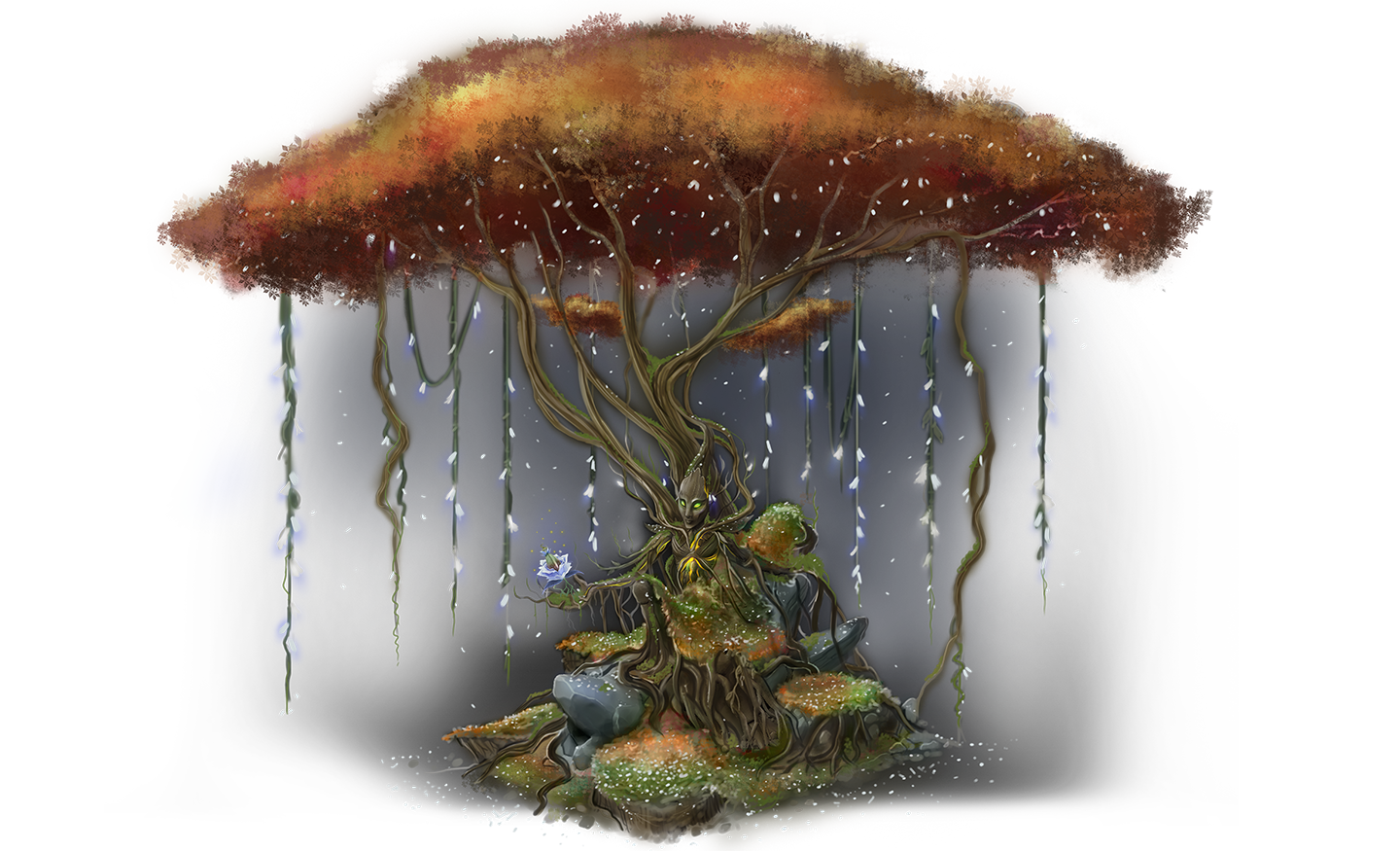
Faerthale
INTRODUCTION
Faerthale, the westernmost seat of Kingsreach. Boasting some of the starkest extremes of any region on the continent, Faerthale holds daunting mountain passes, an enchanting jungle cave, an idyllic river, and several diverse wooded regions.
The southeastern border of Elven dominion begins at the edge of the Silent Plains, while the western edge abuts a tumultuous sea. There the waters of the River N’ylem gush over a cliffside coast, though the pool below garners rare usage by the inhabitants. The sprawling wood that covers the terrain is comprised of two primary sections: the Elven-cultivated Faerthale Forest and the pre-Elven Oldwood. To the North, the Elves carved their capital of Faerthale into the face of Mount Aegis nearly 800 years ago. This lofty mountain preserve has outgrown its original purpose as a fortress, emerging as the steady heartbeat of the Elves’ diverse culture. From this majestic stage, the future of their race is debated, with each of the three branches of their society vying for influence while maintaining peace.
Yet in the center of the city is a natural and supernatural beauty that unifies Elven purpose. Twisting up from the foot of Mount Aegis is the Lucent Tree, a white-leafed monolith of life, light, and divine creation. The origins of the tree trace back with the Elves and their home planet of S’iolaen. The Lucent Tree is the face of their people, more than any single member of their race. And while not a god to be worshipped, the tree is a living monument that links Elves with their tragic past, yet feeds their hope in the future.
May the light of the Lucent Tree guide us in kind as we pass through the regions of this majestic Elven home.
Redgrove
Redgrove is one of the few examples of Elven cultivation of nature within Faerthale. The trees were native to S’iolaen, the Elven homeworld, and are thus placed closest to the gates of the city itself. The road out from the city forks north and south, with the distinct red leaves and white bark of the Redgrove trees following in kind. This wood is meant to be as much a place of rest to the Elven people as their own homes, and the kiss of their influence is soft enough for foreigners to miss entirely.
The Reul Height/Adytum of Aellos
Broken off from the face of Aegis long ago, the Height is a hulking stone that rises up from the Forest like a child sibling of the Roan mountains. Elves see the Height as a symbolic first step toward the heavenly realm of the gods, and upon its peak they built the Adytum of Aellos. Within the heart of the Adytum is a phenomenon known as the Celestial Eye, a rare and mystical lens by which mortals can experience the heavenly bodies as if they were face to face.
Faerthale Forest
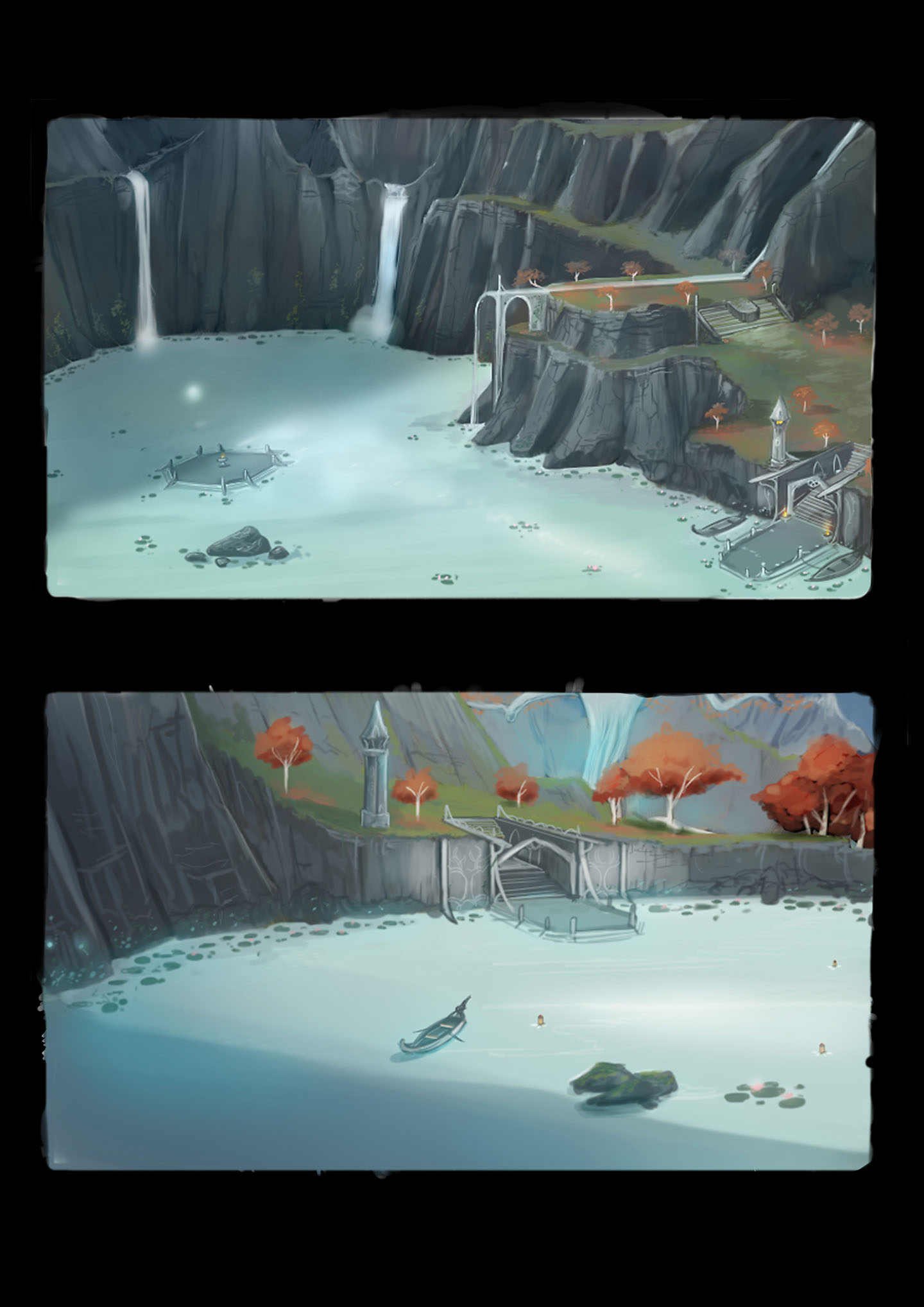
Resurrected from the total devastation of the Deicide War, Faerthale Forest is a living testament to how well Elven craftsmanship melds with the free reign of nature. Trees, plants, and wildlife are a harmonious mix of both S’iolaen and Terminus, reaching an even consistency, as the Elves are careful not to dilute the valley too much with their own influence. To the novice traveller, Elven cultivation of the land is easily missed, as is their intent. Yet when their delicate tells are learned, Elven handiwork becomes wondrously apparent, a language of the eye that speaks of deep affection.
In the early days of Elven rule, the edge of Faerthale Forest was the most a simple adventurer would see of the valley. There were few pathways through the wood, yet they were crafted as much to confuse as to reveal. For in those days, the Ashen way of thinking kept a heavy hand upon the realm, and the need to defend against “the foe unknown” was as important as trade or alliances.
Today the entrance from the Silent Plains is still guarded by the wood, but pass through and you’ll find the hardy residents of Lo’thale give a more hospitable welcome than those years of old.
The Field of Fallen Stars
Elves do not bury their dead. In the days on S’iolaen, their life on the run from the Tohr’mentirii was so nomadic they began to burn corpses rather than bury them. Instead, small artifacts known as Ashstones were created from the remains of the dead, then carried by loved ones, often around the neck or elsewhere. On Terminus this practice is still carried out in a formal but similar manner, with the field serving as a body-less graveyard of headstones.
River N’ylem
Flowing out from the Soul of Aegis and over the roots of the Lucent Tree, the N’ylem is a clear and cold body of water. Never fast or very deep, save for the pools, the N’ylem is essential to the pristine health of both Faerthale Forest and Oldwood, often given a lesser but complementary regard to the Lucent itself.
The Lake of Morning
Fed by a Roan mountain waterfall, this mysterious body of water gifts the valley with a nourishing blanket of fog before each sunrise. Upon its idyllic face dance the Ashrent, luminous spirit creatures formed from the ashes of the dead and the mystical properties of the lake. When the ashrent are ready, they will pass through the Temples of Dusk and Dawn at the foot of the falls, leaving behind the mortal plane forever.
The Lucent Tree
As mentioned, the Lucent Tree is the centrality of Elven culture. Nothing else has so defined their civilization, across two planets and for thousands of years. In truth, the Lucent is the offspring of two previous trees, both of which perished on S’iolaen. This heirloom of Elven existence nearly met the same fate as its forebears when the Revenant took Faerthale 500 years ago. Countless lives were lost defending the tree, most of which were Ashen Elves, even when the chance of victory was long since dead.
Interestingly, if not for the sheer number of Ashen that perished in the last battle for Faerthale, the nascent Ember Elf leadership may not have had an opportunity to form at all. Historians suspect the Ember would never have gotten a foothold if not for the brave, martyred forefathers of their modern day rivals. Yet a vacuum of leadership did emerge after the Deicide War, giving rise to the upstart and passionate third branch of Elven society.
The Mountain Aegis and Faerthale City
Faerthale City is one of the few dwelling places ravaged by the Deicide War that truly regained every bit of its former splendor. For a race that is thought to be stoic unto death by outsiders, the depth of their passion is evident in the resplendent city they rebuilt and even improved upon.
The city itself showcases the ordered preferences of the Elves, but also their belief that nature ought to have a say in craftsmanship. Buildings may be half inside the mountain or half over the edge of a cliff, or both, all by design and careful planning. Faerthale has grown around the heights of Aegis with studious care, ensuring the founders’ concerns for defense are not entirely forsaken.
Faerthale does not have standardized districts like Thronefast, so places of worship or vendors are placed throughout the city with an intent to knit all facets of life together. The construction of the city intentionally made the Crownroom and Lucent Tree visible at nearly all times to Elf and visitor alike. One whose voices fall from on high, the other whose majesty rises up from below.
Crownroom of the Anadem Council
The Council is comprised of the 9 Branches of Oversight, each from a different sector of Elven life. The Crownroom is a symbolic name, as the “crown” does not belong to one Elf but a select body ruling on behalf of the whole. The “room” portion of the name is something of a misnomer as well, as the lofty area is open to the sky without roof or walls of any kind, unless supplied by the arcane. This is to ensure that no words or decisions can be hidden from gods or mortals alike.
The Eternal Veil
The primary hall of the Ashen Order is not completely different from the day the Revenant torched Faerthale. The smoke streaks of the Black Flame are washed away, along with the filth of Revenant corpses. The structure was restored to a safe capacity, yet time there seems to have been locked in place. Where the flame melted the stones, the mineral remains marred. Bloodstains of the Elven dead have been sealed into the floor, a permanent reminder of the heavy steps each member is following in.
As Guardians of the Sephers, the master scrolls of Elven history, Ashen are responsible for maintaining any copies of the ancient scripts. Within their great hold of knowledge and artifacts are actual fibers of the Lumos Tree from S’iolaen, which still radiate heat after over a thousand years.
The Triarc Sun
Carved into the Mountain Aegis, the Triarc Sun is the foundry of Ember Elven identity and a bulwark of their subculture. It is here that the first debates on their purpose and direction were held, deliberating on what made the Ember necessary and distinct, as well as what inclusion in their order would look like. For while they are not true rivals, the differences between Ashen and Ember Elves seem to grow more stark with each passing year. The Ashen have the Wardens of Oldwood, the Ember now have Dythiir’s Hand. The Ashen point to prosperity within, the Ember to the threats without. Even within their sacred halls the distinctions are clear, as the Eternal Veil can seem like a funeral house when compared the more opulent and celebratory Triarc Sun.
Though it is a younger branch of Elven culture, the Ember actually see themselves as hailing a return to the more ancient ways of empire on S’iolaen. Within these stone walls the Ember claim to have the original Signet of the Western Kingdom of S’iolaen, and other artifacts of similar significance.
Soul of Aegis
Rarely explored by outsiders, the cave system known as the Soul remains something of an Elven preserve. Expansive, lush, and bioluminescent, the Soul is seen by the Elves as a pure vault of good nature. Yet this should not give the unwary a feeling of safety, for some of the threats that dwell within this hollow are nearly as formidable as the mountain itself.
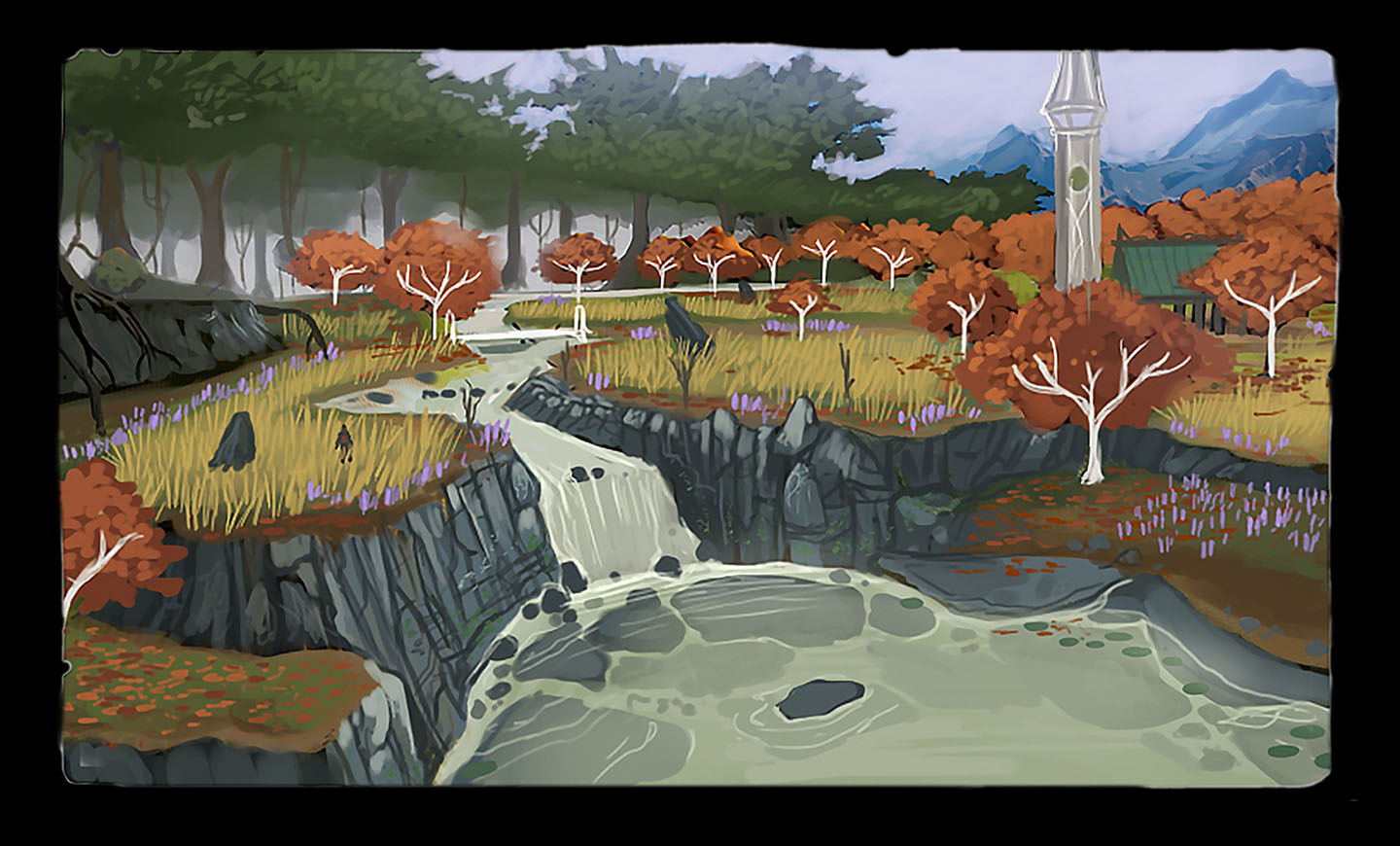
Lothale
Starting off as the testing area for land reclamation after the War, Lo’thale has become a rural take on Elven life. While not great in population, Lo’thale has a vibrant community of mostly Lucent Elves, while a few interested parties keep watch on who enters Elven lands. This modest hub of agriculture has tall fields of wheatgrass that surround a cluster of buildings, while a water wheel provides an appetizing sight for new travellers from the Silent Plains.
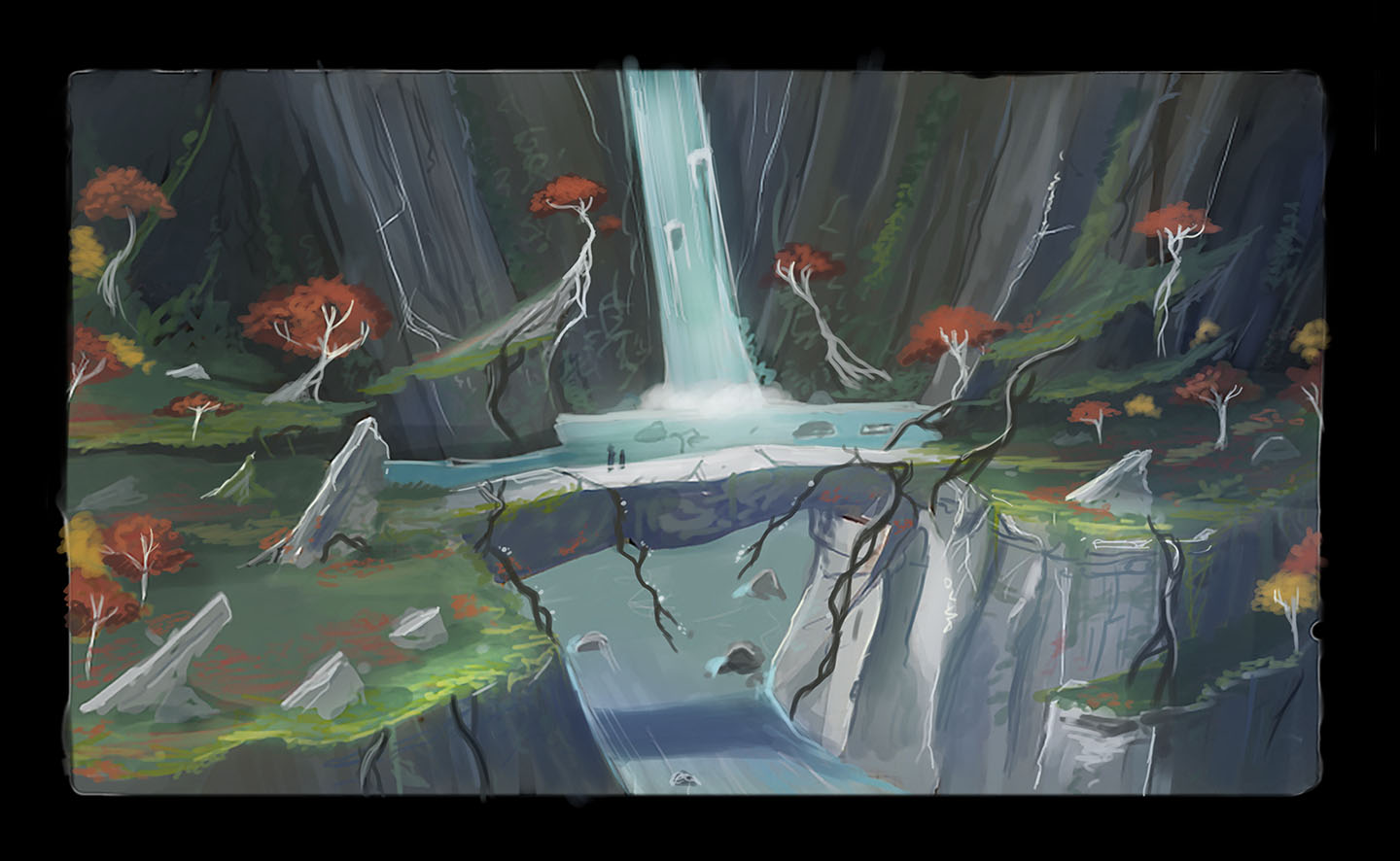
Floor of Heavens/White Gate
The Floor of Heavens is a pressure point for the larger Elven body. Once it was a treasured place of pilgrimage for worship and reflection. Now this border to the Roan mountains is an inhospitable wasteland, watched over only by the Elves of Dythiir’s Hand, who are stationed at the White Gate.
The Floor itself is a series of high plateaus, often with narrow passes in between. Most of the passage remains unrepaired after years of rock slides and clashes between the Elvonnen giants and Colossi of the Roans. While not an outright impasse, the Elves have little desire to keep the corridor open, especially with threats that dwell beyond the otherwise peaceful giants. Without the reclamation and security efforts of Dythiir’s Hand however, the realm may have been forced to confront their northern border with desperation rather than decisiveness.
Oldwood
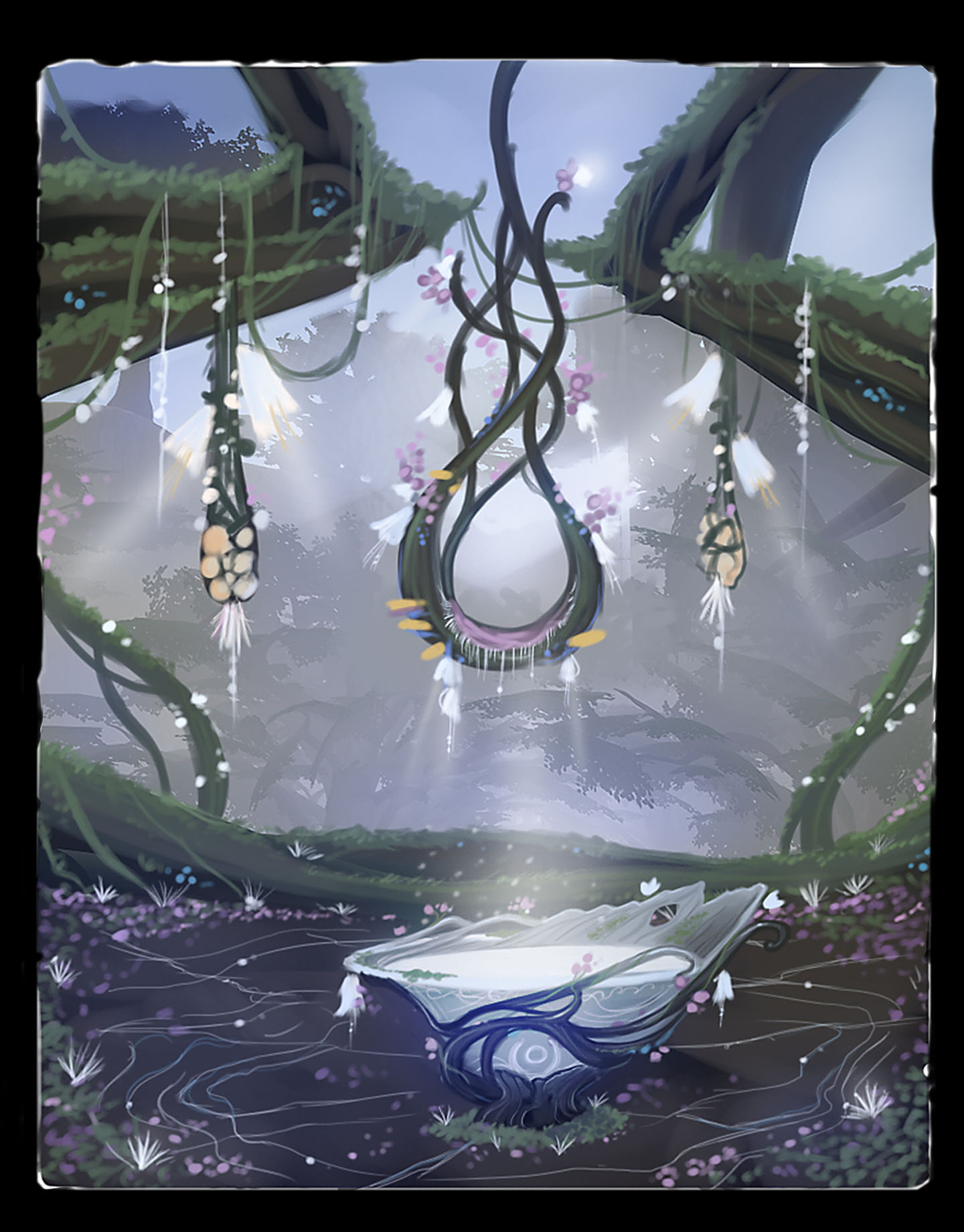
In a world of innumerable old things, the trees of Oldwood are truly ancient. While no longer in as great a number as they once were, the wide area of land they occupy is all that was left when the Elves settled in the region.
The Oldwood growths are immensely tall and twisted, exceptionally wide and almost mindfully spaced apart from each other. The land underneath them has developed undisturbed by the Elves, who see their place more as visitors rather than subjugators. The ecology is peculiar and the terrain demanding. Roots break through the ground and push up boulders, while lush carpets of moss creep over decaying timber.
Fae Hollow
Fae are wild creatures of mystery, magic, and suspicion. Opinions on Fae are often dubious and poorly formed, with few mortals possessing the necessary experience (or patience) to sift for the truth. Part of this confusion is owed to the Fae themselves, as they are a vast host with various loyalties and intentions. The Fae colony in Oldwood behaves quite differently from the one in the Soul of Aegis, though the two are found in relative close proximity to one another. Yet the insular, sometimes chaotic nature of Fae colonies means they are often dismissed by outsiders as nothing more than large, well adorned insects. In truth their habitats are fountains of life, and Fae Hollow depicts this reality with arresting clarity.
The return of Fae to the Hollow of Oldwood was a welcome sign to the residents of Faerthale, and indeed the whole forest. The imperceptible call of Oldwood’s ancient voice, quiet since before the opening days of the War, must have whispered to them anew. Only then would these winged, mystical creatures return, to flourish in the waters of the N’ylem and beneath the twin moons.
Crag of the Hag
The dwelling place of the Grove Hag Notta. Little is known of this creature, and little shall be said. She is the rival of the Fae, in some form, and a blight that even the Elves are wary to avoid.
The Murk
The Murk is a mishap of nature, living and yet dead. This sunken expanse is as ancient as the Oldwood trees, but where they age in grace and majesty, the Murk rots on as a devious and unforgiving twin. Within this twisted grotto the stench of rot is so thick it is said to drift like a fog, choking off light throughout the region.
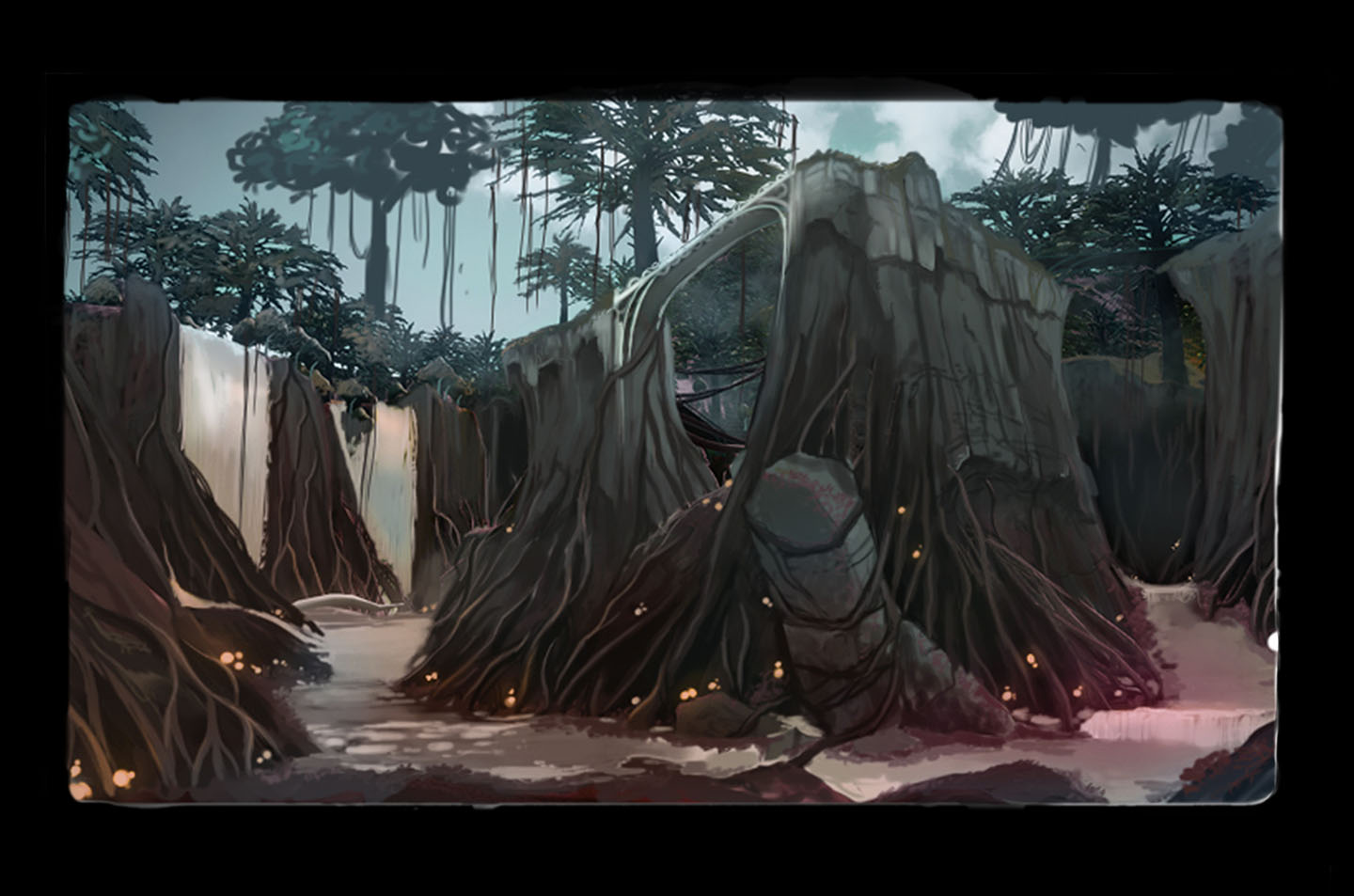
The runoff of the N’ylem is partly to blame for this decay, as the river has been siphoned over the edge of the forest and into bogs on the Murk floor. Whether that flow is a natural course of the river or if lesser hands have turned it to ruin is unknown, but the effect is clear: the trees, roots and soil are rotting alive. The beasts are mad with ferocity and the water is leached with disease and death. No one comes to recover corpses here. Well, almost no one.
The Fens of the Tohrn
The Tohrn are a cult of Elves that have been twisted by the call of Tohrdaenyyr, the god called “The Endless Inferno”. Forsaking every shred of Faerthalean heritage, Tohrn settle in the stomach of the Murk and begin a process of subversion that will strip away their former identity, even eating through their Elvenhood. Set apart from the civilization of their birth, Tohrn continue a primal descent that was likely started within their heart, long before they set foot into this valley of desecration. Once inside the last vestiges of the resilient, observant nature of a Faerthalean Elf withers away, replaced by a paranoid and ruthless zeal. The communal perspective of Elven culture gives way to absolutes of authority and submission, and the value of life is a scale that slides according to the whims of another. The life of a Tohrn is a deconstructed husk of healthy Elven self-discipline, as members of the cult submit themselves to masters who care for little save for strict obedience.
All this in service of the most vile and merciless god of the S’iolyrii, who seems to have once again found himself a living host in a valley of death.